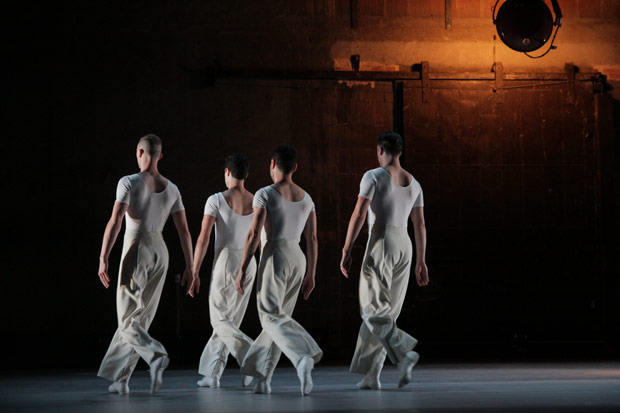
© John Sisley. (Click image for larger version)
Lucinda Childs Dance
Lucinda Childs: A Portrait: Pastime, Katema, Radial Courses, Interior Drama, Concerto, Canto Ostinato, Into View
★★★✰✰
New York, Joyce Theater
30 November 2016
www.lucindachilds.com
www.joyce.org
Trance Dance
The post-modernist Lucinda Childs is experiencing a bit of a comeback here in the US, after years of working abroad. Her company is currently in residence at the Joyce Theater, which is presenting two programs of her work: a retrospective entitled “Lucinda Childs: A Portrait” (this week), followed by a reprise of her famous 1979 work Dance (next week). Interest in her work has been on the rise since Dance was revived here a few years ago. She has reconstituted her company, and has been revisiting the past and even created something new, Into View.

© John Sisley. (Click image for larger version)
Into View, which caps the retrospective, is still very recognizably a Childs creation; so much so that it doesn’t feel particularly original or actually that new, especially when seen after the work that immediately precedes it on the program, Canto Ostinato. Canto was made for the Dutch company Introdans last year and has a sort of deconstructed-waltz theme, and elegant gray costumes. Both are balletic, clean, fluid and include a recent addition to the Childs toolbox: partnering. Perhaps the main difference between the two is that the partnering in Into View looks more square-dance-ish, with lots of hand-holding, and that in Canto Ostinato, more ballet-derived. Both maintain the characteristic Childs impassivity, the fluidity of entrances and exits, the evenness of tone that the choreographer has been cultivating since the sixties. If anything, the new pieces are perhaps a touch less austere. There is color, variation in rhythm, softness in the arms – though, curiously, not in the upper body. Childs’ dancers never seem to twist or soften their necks or shoulders.
The retrospective program is divided into two parts. First come the works from the sixties and seventies. Then, after the break, arrive the works from the nineties and the current century. The second half comes as a relief; relief from the silence to which the early works are set, and from the severe, all-white palette. In the absence of music, the dance creates its own rhythms, visual and aural, set by the sound of footfalls. Unfortunately, unlike with Merce Cunningham, Childs’ rhythmic repertory is rather limited, verging on metronomic. Music adds a layer of syncopation, accent, variety. The surprises in these early works arise almost exclusively out of the variations in pattern. Dancers, deployed in increasing numbers, move in and out of sync, catching up with each other, lagging behind, changing direction, regrouping.

© John Sisley. (Click image for larger version)
The movements are uniformly clean and crisp. There is pleasure in seeing a simple pirouette executed perfectly, a pas de chat springing up and then coming back down, just as there is in hearing one of Philip Glass’s arpeggios, unencumbered by melodic accident or dramatic intention. Nevertheless, a certain sameness takes hold, and the dances tend to outlast their welcome. The earliest, Pastime (1963), is more an absurdist sketch than a dance. Three women engage in simple, almost static tasks, one after the other. One stands and pliés in ¾ profile, swinging her free leg while staring at the audience impassively. Another stretches and un-stretches, encased in a bolt of fabric, like a woman in her bathtub. The third peers out from an uncomfortable-looking four-legged pose. And cut.
After that, the Childs esthetic emerges more clearly. Katema, from 1978, is for four women – hieratic high priestesses – in white. In and out they go, tracing diagonal trajectories, toward and away from each other. The second, Radial Courses, is for four men, moving in circles and semi-circles, in and out of sync. In Interior Drama, the number increases to five; the dancers bob and walk and turn, but now the patterns include sinuous s’s and loops rather than just straight lines and circles. You get the idea.
Concerto, perhaps the most striking work of the evening, follows the break. The cast includes men and women; the costumes are black, unisex, and silky; the movements are more accented, virtuosic and airborne. Childs’ use of the edges of the stage is masterful; watching the dancers appear and disappear from the wings, one begins to feel like one is observing a supremely civilized ecosystem filled with superior, elegant beings. The music – a recording of Henryk Gorecki’s “Concerto for Harpsichord and Strings” – is bracing, almost crazed. Finally, something that makes you sit up in your chair and pay attention.












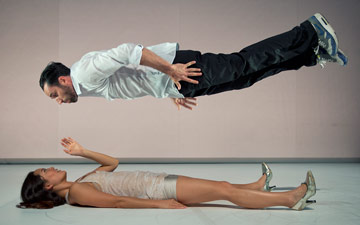

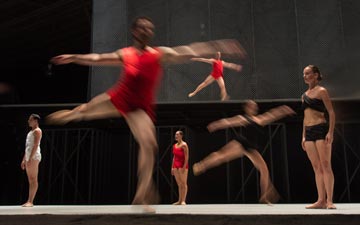
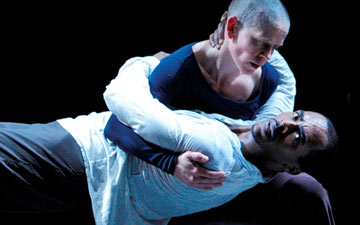
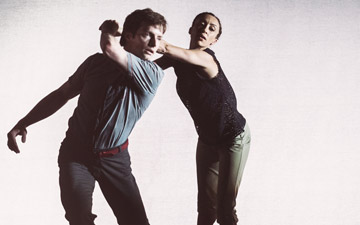
You must be logged in to post a comment.